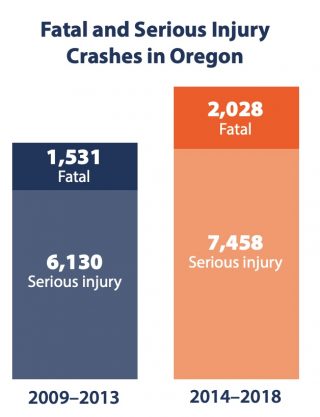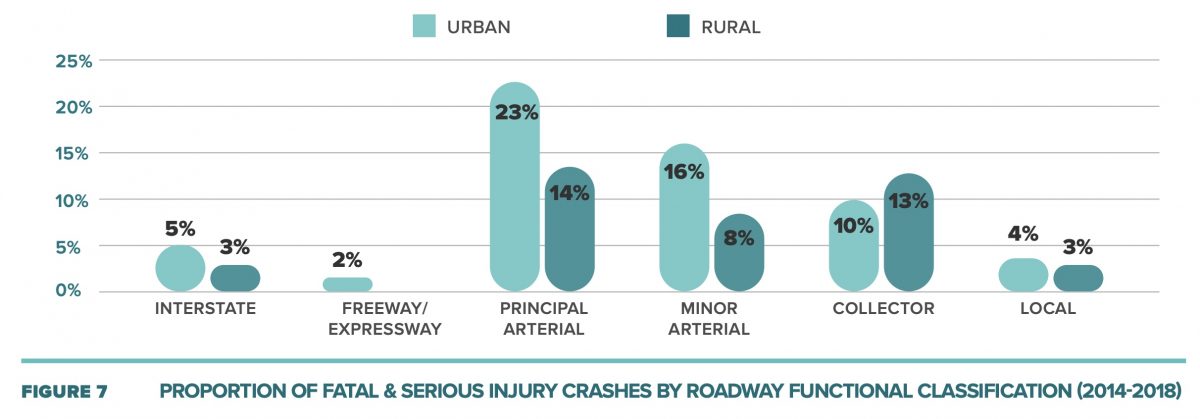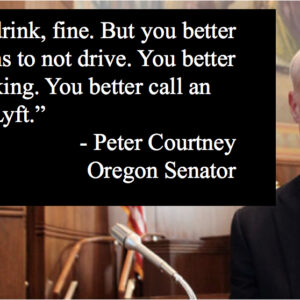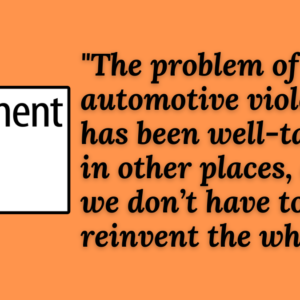
(Photo: Jonathan Maus/BikePortland)
The 502 people who died while using Oregon roads in 2018 was a 15-year high. So far this year, fatal traffic crashes are up over 24% from 2020 levels. Oregon has a lot of work to do if we want to reach our goal of zero deaths or life-changing injuries by 2035.
The roadmap to get us there is the Transportation Safety Action Plan (TSAP), a document required by federal law and created by the Oregon Department of Transportation. A draft version of the latest TSAP is out now and public comments are being accepted until July 9th.
The TSAP is an important tool for advocates and policymakers for many reasons. For one, money flows directly from its findings and recommendations toward programs, city grant disbursements, and so on. The plan can also be a powerful way to hold ODOT accountable for how they manage the transportation system. According to ODOT, this TSAP update,
“… will analyze what has changed since the adoption of the 2016 plan, evaluate the progress towards achieving the elimination of fatalities and serious injuries on Oregon’s transportation system, and identify solutions to address system needs for all travelers.”
Advertisement

[Our coverage of last TSAP update in 2016: Oregon just adopted a new transportation safety plan: Here’s what’s in it]
In addition to the personal trauma and tragedy of traffic crashes, ODOT’s draft plan puts the average annual economic cost of crashes in Oregon over the most recent five-year planning period (2014-2018) at $5.81 billion — more than twice their annual budget.
One way Oregon could save many lives is to focus on arterial roads. Between 2014 and 2018, 61% of all fatal and serious injury crashes occurred on an arterial. The biggest culprit according to official data are “roadway departure” crashes where a person fails to control their vehicle and they leave the road, often smashing into a fixed object. Those type of crashes made up 41% of all fatal and serious injuries in the five-year period. Intersection crashes were second at 36%.
Advertisement

Data is crucial and it’s one area ODOT needs feedback on. “Crash data provides an important starting point toward deciding the distribution of limited resources,” reads the plan. Regulations that would compel first responders and/or law enforcement officials to more thoroughly investigate whether or not a vehicle operator was distracted by a device is one way we might reap safer outcomes.
One proven way to save lives is to reduce exposure to driving cars and trucks — which account for nearly 100% of all deaths and injuries on our roads. ODOT is infamous for being a driving-centric agency and they often make decisions that encourage driving and make it easier and more dangerous at the expense of other modes. If ODOT is serious about reaching a statewide zero fatality and injury goal in 15 years, they must begin to build a system that is much less reliant on the most deadly vehicles. Nothing in this plan alludes to a more low-car future for Oregon.
When it comes to modes, bicycling accounts for the fewest number of fatal and serious injury crashes in Oregon. From 2014-2018, 3.5% of them were to bicycle riders. (Read more about ODOT’s approach to bicycling safety on page 95 of the plan.)
Instead of continuing to invest in traditional safety measures that accept driving hegemony as a given, ODOT could forge a new path and inspire other road agencies (the plan applies to all roads, even ones owned by cities and counties).
Now might be an good time for a consequential TSAP update because long-time leader of ODOT’s Traffic Safety Division, Troy Costales (who I interviewed in 2010), is set to retire on July 1st. In light of that change in leadership, ODOT recently changed the name of that division to the Transportation Safety Office and has housed it in the Department of Motor Vehicles under DMV Administrator Amy Joyce.
“These moves will embed safety experts into areas of the agency responsible for communicating about safety and setting policy,” read an ODOT statement about the organizational shift. “For instance, the Highway Safety Section and DMV already work to provide critical safety information to employees and Oregonians through a variety of programs including driver education, motorcycle safety training, third-party drive testing, driver safety and crash reporting.”
ODOT Assistant Director Travis Brouwer told BikePortland via Twitter in May that the move will come with, “A lot of benefits” and that Joyce, “Has a passion for safety.”
Help all of ODOT have a greater passion to save lives by sharing a comment about the TSAP. See the draft plan here and submit your comments to them via safety@odot.state.or.us by July 9th.
— Jonathan Maus: (503) 706-8804, @jonathan_maus on Twitter and jonathan@bikeportland.org
— Get our headlines delivered to your inbox.
— Support this independent community media outlet with a one-time contribution or monthly subscription.






Thanks for reading.
BikePortland has served this community with independent community journalism since 2005. We rely on subscriptions from readers like you to survive. Your financial support is vital in keeping this valuable resource alive and well.
Please subscribe today to strengthen and expand our work.
To be blunt getting to no deaths by 2035 using the tools the Agency currently has is impossible. Stroads are inherently unsafe no matter how much engineering we throw at them they will remain unsafe stroads. Each stroad in the Metro region needs transition plans to either become streets or roads, hopefully the Metro jurisdictional transfer work can be built off of.
Speed is the problem on urban arterial roadways. More automated enforcement is needed, the Legislature needs to pass a bill, HB3357, allowing people other than police to do this enforcement work and hopefully separate the current conflicts of interest of having the local jurisdiction enforce the State roadway for revenue generation. It would also help from a bureaucratic standpoint if there were an ARTS crash reduction factor for reducing speed limits or thinning lanes on these roadways now that the Blueprint for Urban Design has been published. Unless these things are included in the Agencies methods for Safety fund disbursement they won’t be widely adopted and we’ll keep seeing major funding going to things like supplemental vehicle indications or reflective signal backplates.
https://www.oregon.gov/ODOT/Engineering/Pages/ARTS.aspx
ODOT also needs to adopt something for long range planning allowing Volume/Capacity ratios over 1.0 – a lot of these are safety versus capacity trade-offs and if capacity can’t budge then safety won’t improve.
ODOT’s recent move to stop testing out of State drivers is also the wrong direction to be moving. Only ~75% of drivers know the correct response to a green ball indication much less all the new infrastructure like bike boxes, bike signals, ect… Every registration there should be a written test, able to be taken online or at a Library.
https://www.slideshare.net/otrec/driver-comprehension-of-permissive-rightturns-with-a-flashing-yellow-arrow-fya-primary-tabs
I’ve seen some presentations by ODOT. They acknowledge all of the trends are going the wrong way. They also aren’t doing a major update of the plan. The plan is to do more of the same, which will predictably result in more of the same (increasing deaths and injuries).
While I laud the goal of zero deaths, some of the logic of this piece escapes me. 41% of serious/fatal wrecks were the result of leaving the roadway, i.e. distracted, DUI, etc driving. But, the author’s solution is for ODOT to not cater to automobile drivers. I hate to break it to him, but even incremental change to that metric is a big ask. Cars will always be the main form of transportation for any distance (at least in the lifetimes of anybody reading this), like it or not. I have no idea beyond my opinion, but I am guessing that a 100% increase in enforcement of distracted/DUI driving would reap much greater results than massive expenditures on different forms of travel and/or road re-design. Sometimes, the simplest solution is also the most logical.
Enforcement can only be in so many places at so many times. And the places and times they choose seem to be where the poor and disenfranchised are, the unlawyered masses. Traffic stops aren’t going to stop drunk drivers from driving drunk, or people from texting. But a concrete barrier can stop a drunk texting driver from killing someone. A bollard can save a life 24/7, and will never shoot you because you reached for your wallet too quickly. Enforcement/punishment as deterrence is a flawed strategy-—look at the war on drugs. Using infrastructure to contain and slow car traffic, while providing protected areas for pedestrians and cyclists, is far more effective in the long run.
I was recently hit by an SUV and don’t wish to repeat the experience. The driver circumvented a channelizing island to turn left illegally, striking me as I crossed from a corner.
Until roads protect pedestrians from the fatal threat of vehicular violence, let’s start enforcing laws against drunk driving, street racing, texting while driving, etc.
I’m not “poor and disenfranchised,” but when tallying my relative privilege, account for my permanent limp — and the suffering of the growing cross-section of Portlanders killed or maimed by drivers unbounded by law.
JM, this is a report on all Oregon roadways, not just ODOT. Your negative bias about ODOT is hurting you on this article – a lot of your statements are misleading. Most arterial stroads are not ODOT facilities (though many are), but typically owned by cities and counties. The crash data includes PBOT streets.
“One way Oregon could save many lives is to focus on ODOT-owned arterial roads. Between 2014 and 2018, 61% of all fatal and serious injury crashes occurred on an arterial.” This 61% figure includes data from PBOT-owned and maintained streets too, not just ODOT.
And so on…
Yes thanks David. I hear you. And I acknowledge that mistake of “ODOT-owned”. I’m editing the piece now to better reflect that this is all Oregon roads, not just ODOT.
But keep in mind, it is an ODOT report. They are in charge of it.
And I disagree with you about how my negative ODOT bias hurts anything. I am stating facts about ODOT because of their policies and actions over many years.
I have no issue with you having a negative bias about ODOT; I fully understand your point of view even when I disagree with it, and I dare say my bias about NCDOT is even worse. But it isn’t helping your writing, it’s making it look like it’s all ODOT’s fault for everything bad about Oregon traffic deaths and fatalities, when in fact ODOT plays a role, true, but so do Oregon cities, counties, and residents.
What I find unusual about this report is all the implied criticism the ODOT staffers have for other parts of ODOT, plus all the other factors that create unsafe streets in Oregon. I rarely see similar reports from NCDOT.
I saw this story before it was edited. I’m sorry to say this, but it was straight-up fake news at that point. I agree with you that the current status quo cannot be maintained, and that ODOT (and frankly all US state DOTs) are flawed organizations. But your journalism and even blogging to stay fact-based and very careful not to mislead/lie if you want to maintain credibility. And to be frank, your reporting lately on ODOT-related issues has been consistently misleading.
Hi (person who has no name),
Thanks for the feedback. I understand your concern. But again can you point me to something I’ve typed that is misleading or a lie? ODOT does a lot of very bad things that have very bad consequences and I don’t think being direct about that is problematic. Trying to stay “objective” about that is. And yes, I understand my style is much different than other outlets. But misleading? I totally disagree. I am sharing my opinion which is based on facts and policies of ODOT.
Taken separate, there were no statements that you made that were lies. But when combined together as David mentioned above, the article’s text strongly insinuated that 61% of crashes occurred on ODOT facilities, which is not what the facts said. Roads like Division, Stark, Glisan, Halsey, 122nd, 102nd, Chavez, Scholls Ferry, etc. are all examples of arterials that are not managed by ODOT. So while there were no facts per se in this article that were not accurate, the way they were presented was to create a narrative that was not based in reality.
And I usually appreciate your style, and get that this site is a sort of hybrid between a news site and a blog. Staying objective isn’t always something that needs to be done on a site like this, in contrast to a true news site. But it’s always necessary, even on blogs, to stay true to the facts and not present misleading conclusions.
Ok. Points taken. Thanks for the feedback.
I’m not seeing the bias and misleading that you are. The way I read that statement is “A high percentage of traffic deaths and serious injuries in Oregon occur on arterials. ODOT owns lots of those arterials. So if ODOT focuses on making its arterials safer, Oregon could save many lives.” That all seems true.
As I read it, there’s no implication that ODOT owns all the state’s arterials, or that the crash data doesn’t include arterials ODOT doesn’t own.
ODOT doesn’t even own a majority of the arterial roadway length. ODOT owns the interstates, some of the expressways (but not all), a few major arterial stroads, much fewer collector streets, and even fewer local streets (for example, in state parks).
And of course JM to his credit has responded to criticism by rewriting several paragraphs from the original, so it’s probably just as well you didn’t see them.
I did see the article early on. But that’s irrelevant, since I was commenting on the excerpt you included in your comment. I never expected that ODOT owns a majority of the state’s arterials, either, and it’s not relevant to my comment.
It’s fine if you saw bias and misleading happening. You weren’t the only one. I was only pointing out that I didn’t.
I would like to invite the ODOT staff who came up with that to ride their bike in the shared lane on the St John’s Bridge and then tell me about how strongly ODOT is committed to that goal.
Just this morning, I drove several miles on I-205. When driving at 12 mph over the limit, I estimated that I was passing just about the same number of cars as were passing me. That would suggest that speeds are increasing above what they were a few years ago.
Driving on city streets, I scrupulously drive the speed limit and consistently have cars catching up to me and riding my rear bumper.
I can’t remember the last time I saw a traffic stop by city police or state troopers. Maybe there’s a connection.
Curious – why were you driving at 12 mph over the limit?
Thanks for driving under/at the speed limit on city streets.
As a test to try to determine the a average traffic speed. I started at 5 over and was passed by about eight for every one I passed so I kept increasing my speed.
A lot of people getting paid six figures to sit on their buttery biscuits in a room somewhere in Salem and “envision” while nothing changes for the better.
ODOT performed phenomenally well for me recently on a pedestrian-safety issue. I reported to PBOT that several streets feeding into S Macadam (ODOT Highway 43) have stop bars placed so far ahead of the stop signs that they encourage drivers entering Macadam to drive past the stop signs and stop right in the path of people crossing those streets as they walk along Macadam.
PBOT told me right away that ODOT controls those stop bars, so PBOT forwarded my email to ODOT. ODOT Maintenance moved them within literally 2 or 3 days, and for a change that benefited only pedestrians.
That’s encouraging. See something, say something, and it may get better — noted!
“Now might be an good time for a consequential TSAP update because long-time leader of ODOT’s Traffic Safety Division, Troy Costales (who I interviewed in 1010), is set to retire….”
Jonathan that was a VERY old interview. You look amazing for your age! 🙂
Ugh. Wish I had a proofreader. I will fox right away.